Intro
The 15th and 16th centuries are a period of transition between the Middle Ages and Modern Times. This period, called the Renaissance, is characterized by a series of political, economic, social and intellectual changes. At this time also appears the humanist movement:a philosophy that places the human being and human values at the center of thought. Humanism is characterized by a return to ancient texts, and by the modification of models of life, writing, and thought.
Origin of the Renaissance
The end of the Byzantine Empire
The Byzantine Empire had long since entered into decline. The beginnings of the crisis date back to the capture of Constantinople by the Crusaders in 1204. The Latin barons ruined the city, which never completely recovered from this looting. Moreover, the gap between rich and poor was widening more and more while the resources of the State were dangerously diminishing. Unable to ensure the defense of his own borders, the emperor had to buy peace from the other sovereigns. He had to resolve to entrust the army to mercenaries. Very quickly the Turks threatened the city. Besieged from 1394 to 1402, Constantinople was miraculously saved by the Mongol invasion of Tamerlane. The respite was short-lived. The advent of an energetic sultan, Mehmet II, at the head of the Turkish army, hastened the outcome. In 1453, a powerful Ottoman army settled under the city walls. Constantinople eventually fell under the pressure of the Janissaries. The fall of Constantinople, apparently, did not upset the West:the Christian rulers let the old Eastern Empire crumble. However, this event had important consequences for the countries of Europe. Many Byzantine prelates, artists and scientists took refuge in the West, especially in Italy. They brought their knowledge, their ideas and their libraries of ancient manuscripts. Italian scholars and artists took advantage of the knowledge accumulated in the East. Thus the fall of the Byzantine Empire accelerated the cultural renaissance of the West.
13th century Byzantine mosaic
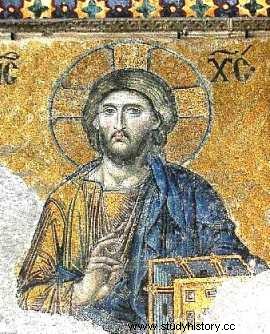
Christ Pantocrator - Mosaic of Hagia Sophia in Constantinople (Istanbul)
A world dies, a world is born
Everyone could see that the great medieval ideal of unity was disappearing. The Middle Ages had sought to realize the dream of universal unity:
- Unity of faith in the Church of Rome.
- Unity of politics under the leadership of the emperor.
- Cultural unity taught by clerics and cemented by a common language:Latin.
We witnessed the gradual erosion of this ideal, replaced by other aspirations. The Church was going through a period of serious crises:schisms and heresies, divisions between popes and antipopes. The Empire still existed and exercised great influence over the Germanic states. But it was becoming more and more a family affair of the powerful lords of Austria, the Habsburgs. Everywhere else, national states asserted themselves:in addition to France and England, Spain, Poland, Scotland, Hungary, Norway and the new state of Burgundy experienced a strengthening of the power of their princes. With the appearance of the banking and merchant bourgeoisie, the feudal state gave way to modern states. The development of national sentiment will prevent any revival of a universal state project.
Chronology of European events
- 1450:Discovery of printing by Gutenberg.
- 1459-1486:Civil war in England between the dynasties of Lancaster and York. Advent of the Tudors.
- 1461-1483:Reign of Louis XI de Valois, who annexed Burgundy after the death, in 1477, of Duke Charles the Bold.
- 1453:Capture of Constantinople by Sultan Mehmet II.
- 1466:After a thirteen-year war, the Teutonic Order recognizes the suzerainty of Poland over Prussia.
- 1479:Ferdinand of Aragon marries Isabella of Castile:the unity of Spain is on the way to being achieved.
- 1458-1490:Mathias I Corvinus establishes a powerful kingdom in Hungary, which he tries to make a bulwark of Christianity against the Turks.
- 1492:The Spaniards conquer the kingdom of Granada, the last Islamic bastion on the peninsula. Christopher Columbus discovers America.
A cultural revolution
The arrival of the humanists
For centuries the elite men had been the warriors, or, towards the end of the Middle Ages, the wealthy merchants and bankers. And then, almost suddenly, everything changed:new men appeared on the front of the stage. This change occurred between the end of the 14th century and the middle of the 15th century. The most admired minds, those who rose to fame, were those who knew several languages, who remained locked up for months in libraries or laboratories. They explored the secrets of nature, whose laws they discovered. They mastered new techniques, invented and built amazing machines. At the same time, they were moved in front of a painting, or by listening to beautiful music, or even by reading a poem. Of course kings and princes still ruled. But they now entrusted the education of their children to scholars and followed their advice. The princes financed the expensive libraries, bought the rare manuscripts and commissioned the paintings. These men living from the things of the spirit were the new heroes of Europe:their promotion represented a veritable cultural revolution. The discovery of manuscripts from ancient Greece and Rome was certainly the element that most favored the development of this movement. The Latin term humanitas gave the name of humanism to the new way of thinking and seeing the world, which paved the way for the marvelous explosion of European civilization.
Famous Humanists
| Erasmus (1469 - 1536) | 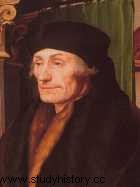 | The Dutch Erasmus of Rotterdam was one of the most eminent figures of humanism. With his many travels, he was able to come into contact with the main cultural movements that were then appearing in Europe. He was a close friend of Thomas More. Among his works, "Eloge de la folie", in which he denounced the corruption and vices of the clergy, thus joining the spirit of the Reformation. However, in his "Essay on Free Will", he defends human freedom and takes a stand against the Lutheran idea of predestination. |
|---|---|---|
| Jean Pic de la Mirandole (1463 - 1494) | 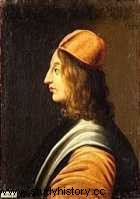 | Known for his prodigious memory and exceptional scholarship, he was one of the most typical representatives of Italian humanism. He notably learned Hebrew, Aramaic and Arabic. He affirmed that Man was placed by God at the center of the Universe with the duty to study the world to understand the laws that govern it and to study himself to understand the demands of his soul. /td> |
| Thomas More (1477 - 1535) | 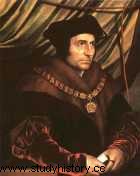 | Thomas More was one of the most remarkable personalities of his time. Chancellor of King Henry VIII of England, he opposed his suzerain when the latter claimed to become supreme head of the Anglican Church. Persisting in recognizing the superiority of the pope, he was imprisoned in the Tower of London. His name is linked to his work in Latin, "Utopia" (1516). Inspired by Plato, he describes an ideal society, installed on an imaginary island, organized according to the rules of peaceful cohabitation and tolerance between people of different beliefs. In Utopia, there is no private property, and all property is held in common. |
The influence of theology
The relationship between Man and God dominated medieval culture. Religion permeated every thought, moment and gesture of medieval man's life. All other activities (art, philosophy, poetry and science) could be noble. But they were first judged on their religious consequences:
- Either they helped man in his walk towards God, and then they were good and like sacred music, edifying poems, paintings and stained glass illustrating the saints, they should be encouraged.
- Or, on the contrary, they did not contribute to it, and then they were regarded as negligible activities, even dangerous insofar as they distracted the spirit from its search for God.
Therefore, the science most valued in the Middle Ages was precisely that devoted to the knowledge of God:theology. The Church and the educated clerics had exclusive rights. However, everything that had been preserved from Greek and Roman antiquity was relegated to monasteries and university libraries. It was the same for the discoveries and the contribution of other civilizations, in particular of the Arab civilization. Since Saint-Benoît and the creation of the Benedictine order, copyist monks devoted themselves to the transcription of these ancient manuscripts. They understood that among them there were masterpieces of poetry and great scientific demonstrations, veritable marvels of the human spirit. But they also knew that they were pagan works, written by authors who had had the misfortune to be born before Christ, or who had not been able to know his message.
A copyist monk
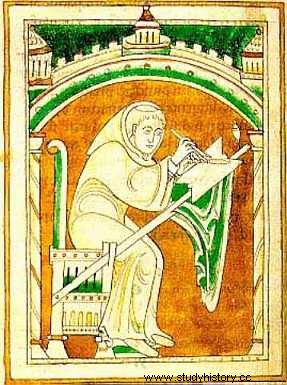
Return of the Ancients
Soon, the works of the Ancients emerged from libraries and universities, where they had remained locked up until then. They began to circulate among students in schools and universities but also in taverns where they met to discuss and amuse themselves. Among these students, there were more and more lay people, that is to say, essentially, sons of the bourgeois; they were the future doctors and lawyers, businessmen, scholars, poets and artists. An entire generation began to be formed by study and in the "ardent passion" of the humanities. In composing new works, the artists sought to draw as much inspiration as possible from the great masters of antiquity. And this fever did not affect only the world of literature and art. Architects and engineers studied the monuments of ancient Rome in order to master the construction techniques of the Ancients. There were also students who dabbled in mathematics, geometry, physics, botany, etc. Thus science and technology progressed in a few decades more than they had done in the previous ten centuries.
Economic boom
An economic revolution
In the 15th century, Europe was in full economic expansion. Italian cities, favored by their geographical location, were the first to take advantage of the economic transformations experienced by the West towards the end of the Middle Ages. Money was needed to pay painters and sculptors, architects, scholars, court musicians… And there was no lack of money. The economic and banking progress of Italy was thus the material basis of the artistic explosion that the peninsula experienced during the Renaissance. It was from the 15th century that Italy began to lose its economic primacy. Other regions of Europe then took off:Flanders, France, Germany, England, etc. The discovery of the New World and the conquest of the great colonial empires marked the beginning of prosperity and colossal power. If Spain was the great beneficiary of these conquests, all the great national states of the continent profited from them. The transformations in the scientific and technical fields, in the world of business and labor heralded a new type of economic organization.
The first bankers
In the first centuries of the Middle Ages, the powerful of Europe were the nobles, the feudal, that is to say the owners of the land. Land was the fundamental good, at a time when agriculture was the predominant activity. From the 15th century, new forms of power emerged:those that depended on the possession of money. The new masters were henceforth the great merchants and bankers. Like the feudal lords, they owned land, farms and castles, but their main strength came from the capital they could dispose of. In the form of cash, goods, precious objects, or securities (a letter signed by a wealthy person promising to pay a sum), capital made it possible to acquire raw materials to manufacture other objects. that we resold. The role of the bank became essential. Lending at interest became widespread. Great bankers (the Pazzi and the Medici in Italy, the Fugger in Germany) created veritable financial empires.
The Mona Lisa
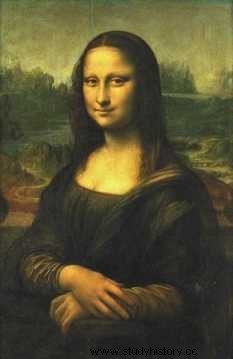
The Mona Lisa - by Leonardo da Vinci 1503-1507 (Louvre Museum, Paris)
The first societies
Competition between French, Flemish, German and Italian merchants forced trade to be considered on a larger scale. Huge capital was needed to allow the loading of several ships. If one did not personally possess this considerable capital, what could one do? We formed a society, a company. The partners each contributed a share of the capital:they themselves or their men of confidence had it to buy goods. Finally, once the business was concluded, the profits made were calculated, and each partner received his share, proportional to the capital contributed. From now on, the isolated merchant or the small craftsman no longer counted, because they could not compete with the powerful companies.
Science and Technology
The invention of the printing press
One of the discoveries that had the greatest impact on Renaissance men was the discovery of the printing press. Before the invention of this process by Gutenberg in 1453, the writing of the books was done by hand, by clerks, who were the only ones capable of mastering the writing techniques:in the 11th century and 12th century, the manuscripts were transcribed by monks in the scriptoria. This was one of the two main tasks of monks at the time; they embellished them with illuminations. On the other hand, the language used in the manuscripts was Latin. Universities had a virtual monopoly in education and the dissemination of information. The powerful universities of Bologna, Paris, Salamanca, Oxford, and Cambridge were the only ones empowered to disseminate knowledge, according to the proven methods of scholasticism. Law was one of the main disciplines in these universities. Knowledge was thus reserved for clerics, who had the necessary education to understand the texts. The printing press suddenly made it possible to open access to knowledge to other circles. It became possible, through the publication of books from the middle of the 15th century…), to better understand the facts. For example, Pierre d'Ailly's Imago mundi was written in 1410 and printed in 1478. It was one of the foundations of geographical knowledge used by Christopher Columbus and navigators during the great discoveries. Printed texts upset the hierarchy of values. At the University of Paris, for example, the faculty of arts became the most prestigious faculty in the sixteenth century, ahead of that of theology. Libraries began to grow. In France, kings installed libraries in their residences.
Printing
Gutenberg didn't actually invent the printing press. A goldsmith by training, he perfected an already existing technique:engraving on copper or wood, only used to reproduce images. After engraving the image on a copper or wooden surface, it was coated with ink before pressing it onto a sheet of paper. Gutenberg has the simple yet ingenious idea of applying the process to movable lead type. Each represents a letter of the alphabet in relief. The assembly line by line of different characters makes it possible to compose a page of writing. We then print identically as many copies of the page. Then, the support is dismantled and a new page is composed with the movable characters. With this technique, we obtain a book with many copies in a short time and at a low cost.
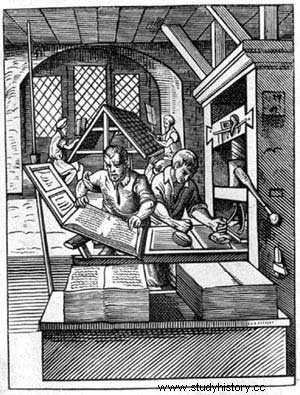
The Copernican Revolution
In the cultured world of Western universities, we had been aware since the integration of the systems of Greek antiquity (Ptolemy, Aristotle, Eratosthenes), that is to say since the 12th and 13th centuries, that the Earth was round. This representation was not yet widespread in Western society before the 15th century. In 1543, the famous work by Nicolas Copernicus appeared, dedicated to Pope Paul III, great protector of the arts and sciences, the very man who hired Michelangelo to decorate the Sistine Chapel. This work upsets the dogmas of official science, by exposing the heliocentric system. The latter, however cautiously presented as a mathematical working hypothesis, and not as a physical reality, will raise scientific-religious controversies during the century that will follow. He will finally triumph in the scientific world, but not without having made very famous victims like Galileo, who had the imprudence to defend him too vigorously against ecclesiastical dogma. In reality, what is called the Copernican revolution is the set of transformations of scientific methods and philosophical ideas from the 16th to the 18th century. These transformations accompanied the change in the representation of the universe, shifting the representations from a geocentric model, according to Ptolemy (Earth at the center of the Universe), to the heliocentric model (Sun at the center of the world) defended by Nicolas Copernicus, then perfected by Tycho Brahe, Johannes Kepler, Galileo, and Isaac Newton.
Galileo's telescope
Galileo perfected the astronomical telescope which allowed him to observe many stars:he was mainly interested in the sun, the moon, the rings of Saturn and the main satellites of Jupiter. To escape religious reprisals, Galileo coded all his writings so as not to be discovered.
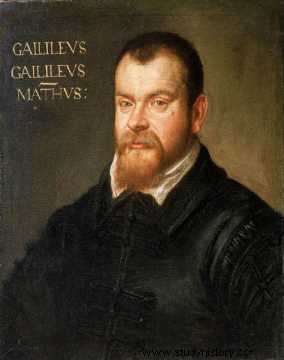
Galileo Galilei - by Domenico Robusti (1605-07)
Military innovations
-
Infantry :Appeared in China in the 6th century, gunpowder arrived in Europe in the middle of the 13th century through the Islamic civilization. In the first quarter of the 14th century, the first hand cannons were developed:the culverins. A simple tube of smooth-bore iron, and inserted into a rounded piece of wood so that it can be held under the arm. Culverins allow you to shoot tiny balls of stone or metal. Around the year 1500, a new weapon appeared and succeeded the culverin:the arquebuse. The arquebus is a firearm with a limited effective range (less than 25 meters), quite heavy and cumbersome but of which the latest versions could be supported. The arquebus with wheel comes later (1550), measures approximately 1m, weighs in the 6 kg. It had a low rate of fire (two or three shots per minute) and its barrel heated up quickly. In France, it was Louis XIII who developed the art of armouring.
-
Artillery :The arrival of gunpowder was to lead to the discovery of propulsive energy which replaced neuroballistic energy (catapults, trebuchets). Thus appeared the bombarde during the Hundred Years War, which launched stone or iron balls. Its lack of precision and low rate of fire made the bombard more frightening and demoralizing than deadly. Little by little, metallurgy found better techniques and materials for the manufacture of parts, they began to use bronze which, although more expensive, had the advantage of deforming rather than bursting.
-
Fortifications :At the end of the Middle Ages, siege artillery became so effective that fortification techniques had to be completely rethought. There is no longer an impregnable fort, because the higher a wall, the more vulnerable it is to the firing of metal cannonballs. The fortification must evolve in the face of this new threat. From the 14th century, cannon towers appeared, low and massive, which reinforced the existing forts. The height of the towers and curtain walls decreases. The structure then barely emerges from its ditch, which has taken over the function of an obstacle. The curtain walls lose their crenellations, in favor of embrasures for the defense guns. It introduces the glacis, a gently sloping area, which makes it possible to offer no shelter for the attackers who are now in the field of vision of the defenders. Another novelty, the covered way, which separates the ditch from the glacis:it makes it possible to deploy musketeers, to shoot any assailant who ventures on the glacis. In France, these fortification techniques will be rationalized and then improved, notably by Vauban.
Ambroise Paré, military surgeon
A great French figure of the 16th century, Ambroise Paré is the battlefield surgeon, the father of modern surgery. He is the inventor of many instruments. The new use of firearms leads to new wounds that are cauterized with hot iron or boiling oil at the risk of killing the injured. He developed the ligature of the arteries, which he substituted for cauterization, in amputations. Ambroise Paré is also the surgeon of kings Henri II and his descendants:François II, Charles IX and Henri III.
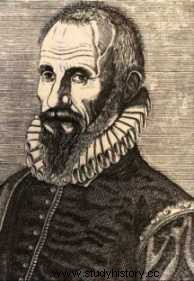
Other technical advancements
- The mechanical clock appeared in Italy as early as 1280, and replaced hourglasses and water clocks during the Renaissance.
- Stained glass, white glass, etc. The use of windows developed in the 16th century.
- Textile:Perfection and generalization. Using the spinning wheel, knitting technique.
- Metalworking:During the Renaissance, more and more gold, silver, iron, copper were used.
- Ceramics
The development of the arts
Literature
The 16th century was marked by the appearance of the modern French language, supported by the royal power of François I, who, with the edict of Villers-Cotterêts (1539), gave this language its status as the official language of law and of the administration of the kingdom of France. The use of Latin begins to decrease, the dialects continue to be spoken by the vast majority of the population. The century is marked by a break with medieval literature. At the same time, new poetic forms appear (ode, sonnet, etc.). Notable writers are:
- Guillaume Budé (1468 - 1540), friend of Erasmus, Rabelais, Thomas More, is a Hellenist, philologist (he had a rich library), theologian. He founded the Collège de France (1530) at the request of François I.
- Francois Rabelais (1494 - 1553) was a churchman and physician; his novels like Pantagruel then Gargantua (Pantagruel's father) combine earthiness and erudition, and develop an optimistic humanism that believes in man and his free will without ceasing to believe in God.
- Michel de Montaigne (1533 - 1592), French writer, philosopher of skepticism:he does not understand the quarrels between Catholics and Protestants, he is the author of Essays. His work, Les Essais, affirms the rights of individual conscience, and formulates humanist principles:justice, freedom, respect for man, right to happiness...
The Pleiade
La Pléiade is the name given to a group of seven poets, in reference to the seven daughters of Atlas, heroes of Greek mythology. This name has been given to several groups of poets over the centuries. In the 16th century, in Paris, a group was formed which brought together great poets, such as Pierre de Ronsard (Les Odes) or Joachim du Bellay (Defense and illustration of the French language). They break with medieval poetry and seek to practice their art in French. Noting the poverty of the French, they will enrich it with many words from Latin (neologisms). At the request of François I, they participate in the development and standardization of French. The modern Frenchman owes them a lot.
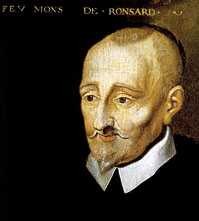
Pierre de Ronsard - painting from the School of Blois - 16th century
Architecture
Renaissance architects pushed back Gothic architecture and returned to the forms and proportions of ancient Roman architecture. For this, artists go to Rome to study the remains of ancient monuments. They then favor aesthetics, organization, harmony and beauty, rather than technique and prowess. Among other things, we notice a respect for proportions, symmetry and regularity (connections at right angles). An abandonment of stained glass for a rediscovery of ancient techniques (the column as well as the dome). Marble is used frequently. The most obvious manifestation of the Renaissance in France was the construction of residential castles in the Loire Valley (see article The castles of the Loire)
The Duomo of Florence
A technical prodigy:Brunelleschi's dome. At this height, the usual construction methods of covering the building with earth are no longer applicable. The architect used an elaborate system of beams to build the dome, which made the reputation of the entire city of Florence.
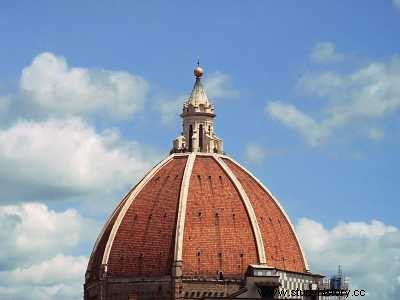
Sculpture
The Renaissance in sculpture is earlier than in the other arts. Indeed, the men of the Renaissance still have ancient sculptures while the paintings have more largely disappeared. This renaissance can be dated, as to its origin, to the 13th century, and originated in the city of Pisa, which is the place of conservation of a large number of ancient sculptures. This is when the nude reappeared in sculpture, long before Michelangelo sculpted his David or Donatello his Bacchus.
David, by Michelangelo
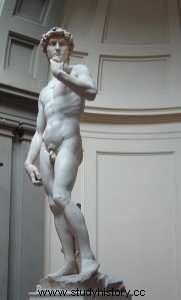
David - by Michelangelo (Piazza della Signoria, Florence)
Painting
The nude is painted for itself, it becomes a subject in its own right and an aesthetic expression. Landscapes are also gaining importance and are made for their intrinsic value, especially by the painters of Flanders who inaugurate a long tradition. In the 16th century, the princes began to build up veritable collections of paintings. Allegories and mythological subjects allow secular iconography to develop. The portrait is diffused in the bourgeois circles of the Renaissance. The most famous is Leonardo da Vinci's Mona Lisa. They grow in size and immortalize kings on horseback. However, Renaissance art continues to depict Catholic themes. The century also saw the installation of new tools:new varnishes, canvas (which replaced wood), easel; and new techniques:central perspective, frescoes on walls and ceilings, light and shadow effects, etc.
The School of Athens, by Raphael
This illustration of Philosophy allows Raphael to bring together the major figures of ancient thought inside an ideal temple, inspired by Bramante's project for the realization of the early Christian basilica of Saint Peter in Rome.
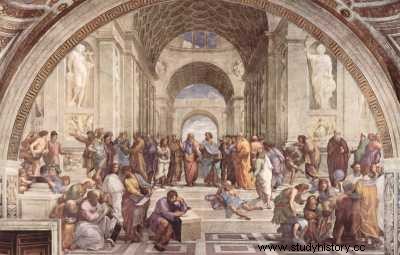
The School of Athens - by Raphael (Vatican Museums - Sistine Chapel)
Patrons
The princely courts are privileged places for the flowering of Renaissance culture. In the artistic field, many patrons (generous patrons of literature, science and the arts) have built up important collections. They all belong to the aristocracy of power (princes, dukes, kings, pope) and of the economy (great merchants who invest their money in artistic production). Les mécènes célèbres :
- Les Medicis :Laurent le Magnifique soutient la création artistique de Verrocchio et de Botticelli.
- Les commandes des Montefeltro concernaient des domaines aussi variés que la bibliophilie, les tapisseries ou les peintures.
- Ludovico Sforza (1452-1508), duc de Milan, fit travailler Léonard de Vinci et Bramante.
- Les papes font travailler les artistes de la Renaissance à Rome :Michel-Ange peint la chapelle Sixtine, Alexandre VI Borgia (1492-1503), Jules II (1503-1513), Léon X (1513-1521), Paul III Farnèse (1534-1549)
- En France, les guerres d'Italie sont l'occasion pour les rois d'entrer en contact avec l'art de la Renaissance et de piller quelques uns de ses chefs d'œuvre. François Ier invite des artistes italiens (Léonard de Vinci à Amboise; Benvenuto Cellini, Rosso Fiorentino, Primatice à Fontainebleau...).
- Les marchands deviennent aussi des amateurs d'art :Jacques Cœur dans la France du XVe siècle siècle, le riche banquier italien Roberto Strozzi en 1489...
Le maniérisme
Le maniérisme, aussi nommé Renaissance tardive, est un mouvement artistique de la période de la Renaissance allant de 1520 (mort du peintre Raphaël) à 1580. Il constitue une réaction face aux conventions artistiques de la Haute Renaissance, réaction amorcée par le sac de Rome (Charles Quint en 1527) qui ébranla l'idéal humaniste de la Renaissance. Contrairement aux précédents mouvements artistiques, la diffusion s'amorçant, il n'est plus circonscrit à l'Italie. En réaction à la perfection atteinte durant la Haute Renaissance dans la représentation du corps humain et dans la maîtrise de l'art de la perspective, certains artistes ont cherché à rompre délibérément avec l'exactitude des proportions, l'harmonie des couleurs ou la réalité de l'espace, de manière à atteindre un nouvel effet émotionnel et artistique. C'est ainsi que l'on voit les œuvres maniéristes présenter :un espace désuni, une image trouble et obscure, une déformation et une torsion des corps, des tons acides et crus. Le maniérisme préfigure les tendances du baroque.
Laocoon, oeuvre maniériste
Dans la mythologie grecque, Laocoon est l'un des protagonistes de l'épisode du cheval de Troie.
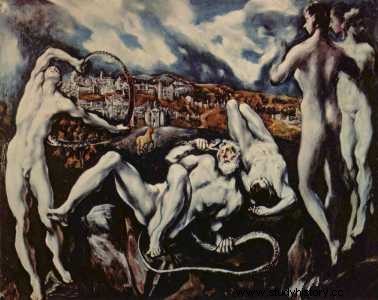
Laocoon - par El Greco 1604-1614 (National Gallery of Arts - USA Washington)
Classification of art movements
- High Middle Ages
- Art du Haut Moyen Âge
- Late Middle Ages
- Romanesque
- Gothic art
- Rebirth
- Pre-Renaissance (1300-1400)
- Première Renaissance (1400-1500)
- High Renaissance (1500-1530)
- Late Renaissance or Mannerism (1520-1580)
- 17th century
- Baroque/Classicism
- 18th century
- Rococo
- 19th century
- Neoclassicism
- Romanticism
- Realism
- Impressionisme
